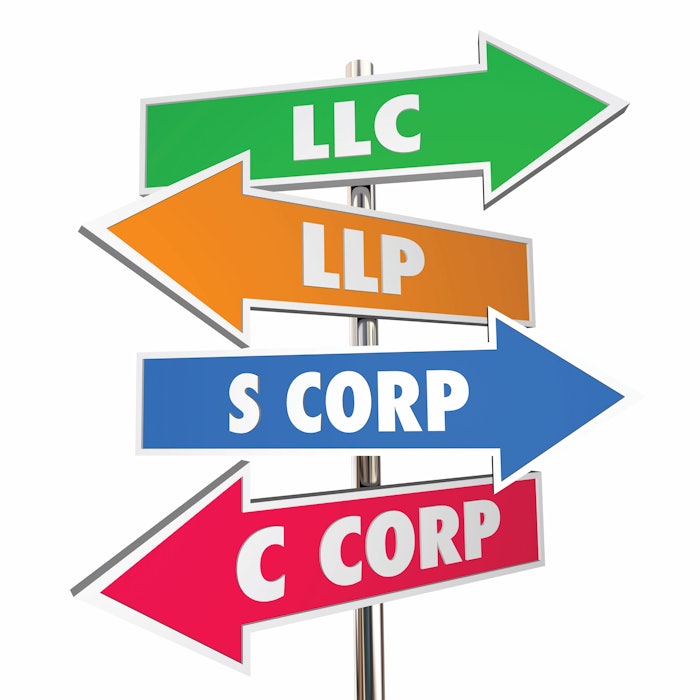
Choosing the right legal entity or business structure is a very important step in the life of an aesthetic practice. The entity you choose helps determine the roles and responsibilities of the owners, guides you in operating your business and determines the consequences of leaving or ending your business, among other things. This article can help you think through the most important questions related to your choice of entity. Entities are state-created legal organizations, and thus, the laws that govern them are specific to each jurisdiction. Most states provide for the following types of business structures: Corporations, Partnerships, Trusts and Limited Liability Companies. Note that a state corporation includes “C-Corporations and S-Corporations.” The “C” or “S” before corporation refers to the two ways that Federal tax law treats a state corporation.
Related: 8 Key Types of Insurance Policies for Beauty Businesses
What Are Your Options for Structural Entities?
C-Corporations
- Ownership: Owners are called “shareholders,” and an owner’s interest is represented by the number of shares owned. The owners elect a board of directors who then delegate the day to day management of the business.
- Limited Liability: For claims against the corporation, owners are only liable to the extent that they have invested in shares. Creditors of the corporation cannot seize personal assets of the corporation’s owners.
- Taxation: The biggest downside of corporations is that both the entity and its owners pay taxes on the same income. This is referred to as double taxation of a C-Corp., although payments to employees (including owner employees) are only taxed to the wage earner.
- Capital Funding: Unless the owners believe that they will require substantial outside financing, a C-Corporation, although familiar, may not be your best choice.
S-Corporations
- Ownership: S-Corporations are a special type of C-Corporation, so for state law purposes the ownership structure is the same. Owners purchase shares representing their ownership interest in the corporation. Owners then elect directors to govern the business.
- Limited Liability: For claims against the corporation, owners are only liable to the extent that they have invested in shares. Creditors of the corporation cannot seize personal assets of the corporation’s owners.
- Taxation: S-Corps are pass-through entities for tax purposes making them similar to LLCs, which are discussed below.
- Capital Funding: Similar to C-Corporations, S-Corps are able to raise capital through the sale of stock. S-Corps have a number of ownership requirements, so these limits might constrain using an S-Corp for your business.
Limited Liability Companies (LLCs)
- Ownership: Owners are called “members.” Members can manage the business or they can delegate to a manager. LLCs are very flexible structures in terms of management, operations and taxation.
- Limited Liability: LLCs provide limited liability to all of its owners, similar to corporations.
- Taxation: LLCs (if treated as a partnership) are subject to passthrough taxation. This means that the LLC does not pay taxes. The business’ profit or loss is divided among the owners, and they each pay any taxes on their share of profits. Often, the LLC will reduce overall individual taxes, especially in the early years of the business.
- Capital Funding: LLC owners may sell their LLC interests, subject to the LLC operating agreement. Securities laws may also apply.
Partnerships
In today’s world, LLCs have largely replaced many partnerships. However, depending on the type of business, some states require that a partnership be used. It is important to consult the laws of the state you will be operating your business in.
Sole Proprietership (NOT Recommended for Aesthetic Practices)
- Ownership: For the Sole Proprietor (SP), the law does not differentiate the individual from the entity. Typically, one individual operates his/her business through their own finances.
- Limited Liability: Creditors of a SP can seize the assets of the business AND all of your personal assets. Therefore, most businesses choose to operate in one of the entity forms that limit the owner’s personal liability.
- Taxation: Because neither the state nor the federal government recognize a SP as a separate entity, all business activities are reported on the individual owner’s tax return.
- Capital Funding: Individual funding is required. Thus, funding for the business will depend on the owner’s sources of capital.
For more detailed information, particularly for additional details on the differences in requirements depending on the state you wish to operate in, you can visit the Small Business Association’s website and the IRS website. Finally, always seek the advice of a business/tax expert before you make these decisions.











